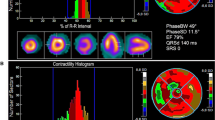Abstract
While there have been many descriptions of characteristic motion findings in left bundle branch block (LBBB), there are few published descriptions of such findings in right bundle branch block (RBBB). The purpose of this study was to assess the frequency of particular regional motion findings in cardiac magnetic resonance imaging (CMR) studies of patients with RBBB, compared with normal subjects. We focused on three distinctive motion patterns that can be seen in RBBB during early systole: delayed apex-ward motion of the RV base, “reverse septal flash”, and “basal bulge”. The presence and relative magnitude of these findings were independently scored by four experienced observers, in 3-chamber and 4-chamber CMR cines, for both normal subjects and patients with RBBB. These motion patterns were found to be strongly associated with the presence of RBBB. While only moderately sensitive, they were quite specific for RBBB, when present. In particular, with ROC analysis, a combined feature set of the findings in the 4-chamber view had an area under the curve of 0.81.This previously undescribed set of RBBB-associated early-systolic regional motion features (delayed apex-ward motion of the RV base, “reverse septal flash”, and “basal bulge”) is strongly suggestive of RBBB when present, particularly in the 4-chamber view. Although here evaluated with CMR, it is also likely to be associated with RBBB when seen with other cardiac imaging modalities.

Similar content being viewed by others
References
Bussink BE et al (2013) Right bundle branch block: prevalence, risk factors, and outcome in the general population: results from the Copenhagen City Heart Study. Eur Heart J 34(2):138–146
Revah G et al (2016) Cardiovascular magnetic resonance features of mechanical dyssynchrony in patients with left bundle branch block. Int J Cardiovasc Imaging 32(9):1427–1438
Park DH et al (2017) Association between right ventricular systolic function and electromechanical delay in patients with right bundle branch block. J Cardiol 70(5):470–475
Marterer R et al (2015) Cardiac MRI assessment of right ventricular function: impact of right bundle branch block on the evaluation of cardiac performance parameters. Eur Radiol 25(12):3528–3535
Rosenbush SW et al (1982) Sequence and timing of ventricular wall motion in patients with bundle branch block. assessment by radionuclide cineangiography. Circulation 66(5):1113–1119
Shapiro J, Boxer R, Krongrad E (1979) Abnormal septal motion in patients with postoperative right bundle branch block pattern. Am Heart J 97(2):147–154
Dwivedi A, Axel L (2017) Abnormal motion patterns of the interventricular septum. JACC Cardiovasc Imaging 10(10 Pt B):1281–1284
Rosenbaum MB (1968) Types of right bundle branch block and their clinical significance. Electrocardiology 1(2):221–232
Janousek J et al (2017) Pulmonary right ventricular resynchronization in congenital heart disease: acute improvement in right ventricular mechanics and contraction efficiency. Circ Cardiovasc Imaging 10(9):e006424
Funding
The authors declare that no funds, grants, or other support were received during the preparation of this manuscript.
Author information
Authors and Affiliations
Contributions
All authors contributed to the study conception and design. Material preparation and data collection were performed by LA; image analysis was performed by LA, MK, GVG, and EG; and statistical analysis was performed by JSB. The first draft of the manuscript was written by LA and all authors commented on subsequent versions of the manuscript. All authors read and approved the final manuscript.
Corresponding author
Ethics declarations
Competing interest
The authors declare no competing interests.
Ethical approval
This study was performed under a retrospective research study protocol (i19-01868) approved by the Institutional Review Board; informed consent was waived for the study.
Additional information
Publisher’s Note
Springer Nature remains neutral with regard to jurisdictional claims in published maps and institutional affiliations.
Supplementary Information
Below is the link to the electronic supplementary material.
Supplementary file1 (MP4 830 kb) VIDEO 1 4-chamber cine of an 11-year-old girl with tetralogy of Fallot and RBBB, showing motion alterations
Rights and permissions
Springer Nature or its licensor (e.g. a society or other partner) holds exclusive rights to this article under a publishing agreement with the author(s) or other rightsholder(s); author self-archiving of the accepted manuscript version of this article is solely governed by the terms of such publishing agreement and applicable law.
About this article
Cite this article
Axel, L., Kanski, M., Gomez, G.V. et al. Cardiac MRI of characteristic motion findings in right bundle branch block. Int J Cardiovasc Imaging 40, 167–176 (2024). https://doi.org/10.1007/s10554-023-02984-x
Received:
Accepted:
Published:
Issue Date:
DOI: https://doi.org/10.1007/s10554-023-02984-x




